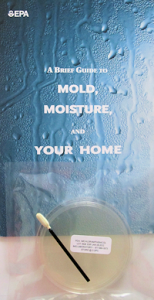Mold thrives in dark, damp and out-of-the-way places, which means that the basement in your home is an ideal place for mold to grow. Below are some steps that you tackle that basement mold removal project.
Step 1 – Reduce Mold Growing Conditions
The first step to take when addressing mold in the basement is to remove or reduce those conditions that are encouraging mold growth. Remember, mold loves those dark and damp places. If your basement has windows or doors, open them, especially on hot, dry days when that warm, dry air can flow into the basement to help it dry. A fan or two can help keep that air flowing and further help your basement to dry out.
Running a dehumidifier in your basement can help remove moisture from the air and decrease mold growth. While dehumidifiers can be a little more on the expensive side, they can be worth their weight in mold when attempting to prevent mold growth through air humidity control. Dehumidifiers are notorious for breaking down, so when purchasing a dehumidifier it is highly recommended to get one with some kind of protection plan that will cover parts and labor when your dehumidifier decides to stop working. Be sure to regularly wipe down the dehumidifier with a disinfecting mold cleaning solution to prevent mold spreading by way of the dehumidifier.
Reduce the amount of outside water draining toward your home. This can be done by ensuring that all rain gutters and drainage pipes face away from your home and drain toward an area that slopes away from the house. Heaping up soil around the base of your house can help create that downward slope away from your home that will minimize water entering your basement and prevent those conditions that encourage mold growth.
Step 2 – Locate the Source of Your Moisture Problem
Locate the source of any moisture. Where there’s mold, there’s moisture. While there are a number of ways that water can get into a basement, the most common ways are flooding, gutters, cracks in the foundation, leaking pipes, and a dryer in the basement that is not vented to outside the home. Reducing moisture is probably the single biggest factor in basement mold removal.
Step 3 – Basement Mold Removal, Do It Yourself Style!
Once you’ve found and eliminated the source of moisture that is causing the mold problem, and after drying out the damp area and removing those mold growth conditions described above the best you can, it’s time to remove the mold. Be sure to wear protective clothing and gear when removing mold, including safety glasses, a respirator mask, gloves, and protective clothing.
Next, bag and remove all removable, contaminated items, such as furniture, boxes, clothes, and building materials, such as carpet in finished basements. These can be taken outside and either cleaned or discarded. Building materials and any cellulose products — such as cardboard boxes, newspapers, etc. — should be thrown away. Clothes can be thoroughly washed and dried. Other mold-resistant material can be scrubbed with your mold removal solution and air-dried.
Now, take your mold removal solution and get to work. Remember to scrub not only those exposed surfaces, but also those harder-to-see places, such as cracks and crevices, where mold loves to hide. Be sure to rinse your scrubbing tool (i.e. brush, cloth) regularly to prevent recontamination. Once the mold removal solution has been applied and the contaminated areas have been scrubbed clean of all mold, wipe down the areas with fresh, clean water, changing your rinse water regularly.
Step 4 – Dry Out the Basement Completely
Finally, dry out the basement. This is key to ensuring that, once the mold has been removed, it will not return. Go back to Step 1 above to remember ways to dry out your basement, including opening windows and doors to increase air ventilation, setting up oscillating fans to increase air flow, and a dehumidifier to reduce the amount of humidity in the air.
And remember, if the mold problem reoccurs, or if it seems too much for you to handle on your own safely and effectively, it might be time to seek the help of a professional. Mold removal professionals can help you get rid of that basement mold problem in a safe and effective manner, keeping you, your home and your loved ones healthier, happier and mold-free.
If you would like to discuss your basement mold removal issues with someone who has the same problem, you might try going on to The Mold Blog’s question & answer section.



